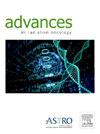Interobserver Variability in a Spanish Society of Radiation Oncology (SEOR) Head and Neck Course. Is Current Contouring Training Sufficient?
IF 2.7
Q3 ONCOLOGY
引用次数: 0
Abstract
Purpose
External beam radiation therapy has grown significantly, incorporating advanced techniques like intensity modulation or stereotactic treatments, which enhance precision and accuracy. Nevertheless, variability in target volume delineation by radiation oncologists remains a challenge, influencing dose distribution. This study analyzes an online training course by the Spanish Society of Radiation Oncology, focusing on head and neck tumor contouring, to evaluate interobserver variability.
Material and Methods
Eight instructors provided clinical directives for 8 head and neck pathologies. Participants contoured structures using their own treatment planning systems, emphasizing gross tumor volume and high-, medium-, and low-risk clinical target volumes (CTV) contouring. Delineation variability was evaluated using the Dice similarity coefficient and volume relative change.
Results
The results reveal significant variability in contouring, with mean Dice similarity coefficient values ranging from 0.57 to 0.69. High-risk CTV demonstrated higher variability compared with medium-risk CTV. The presence of a gross tumor volume and supporting positron emission tomography/computed tomography or magnetic resonance imaging studies did not significantly improve the concordance. Parotid cases exhibited the greatest differences.
Conclusions
Despite the introduction of new automatic tools, this study points to the need for uniform contouring criteria. Training and standardization efforts are essential to enhance radiation therapy treatment consistency and quality.
西班牙放射肿瘤学会(SEOR)头颈部课程中的观察者间差异。目前的轮廓培训是否足够?
目的 体外射束放射治疗已取得了长足发展,并采用了强度调制或立体定向治疗等先进技术,从而提高了精确度和准确性。然而,放射肿瘤学家在靶区划分上的差异仍然是一个挑战,影响着剂量的分布。本研究分析了西班牙放射肿瘤学会(Spanish Society of Radiation Oncology)的在线培训课程,重点是头颈部肿瘤轮廓的绘制,以评估观察者之间的变异性。参与者使用自己的治疗计划系统进行结构轮廓描绘,强调肿瘤总体积和高、中、低风险临床目标体积(CTV)轮廓描绘。结果显示,轮廓描绘存在显著差异,平均 Dice 相似性系数值从 0.57 到 0.69 不等。与中危 CTV 相比,高危 CTV 的变异性更高。有肿瘤总体积和支持正电子发射断层扫描/计算机断层扫描或磁共振成像研究并不能显著提高一致性。结论尽管引入了新的自动工具,但本研究指出需要统一的轮廓标准。培训和标准化工作对于提高放射治疗的一致性和质量至关重要。
本文章由计算机程序翻译,如有差异,请以英文原文为准。
求助全文
约1分钟内获得全文
求助全文
来源期刊

Advances in Radiation Oncology
Medicine-Radiology, Nuclear Medicine and Imaging
CiteScore
4.60
自引率
4.30%
发文量
208
审稿时长
98 days
期刊介绍:
The purpose of Advances is to provide information for clinicians who use radiation therapy by publishing: Clinical trial reports and reanalyses. Basic science original reports. Manuscripts examining health services research, comparative and cost effectiveness research, and systematic reviews. Case reports documenting unusual problems and solutions. High quality multi and single institutional series, as well as other novel retrospective hypothesis generating series. Timely critical reviews on important topics in radiation oncology, such as side effects. Articles reporting the natural history of disease and patterns of failure, particularly as they relate to treatment volume delineation. Articles on safety and quality in radiation therapy. Essays on clinical experience. Articles on practice transformation in radiation oncology, in particular: Aspects of health policy that may impact the future practice of radiation oncology. How information technology, such as data analytics and systems innovations, will change radiation oncology practice. Articles on imaging as they relate to radiation therapy treatment.
 求助内容:
求助内容: 应助结果提醒方式:
应助结果提醒方式:


